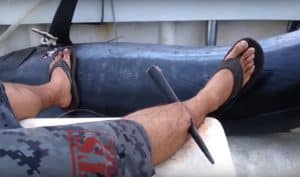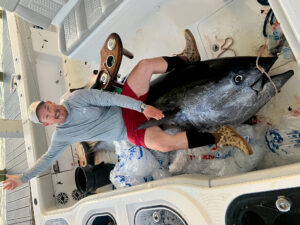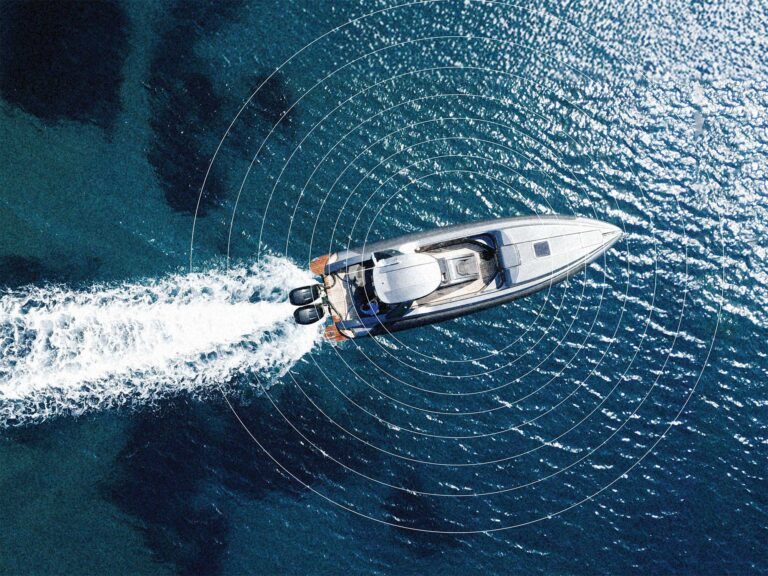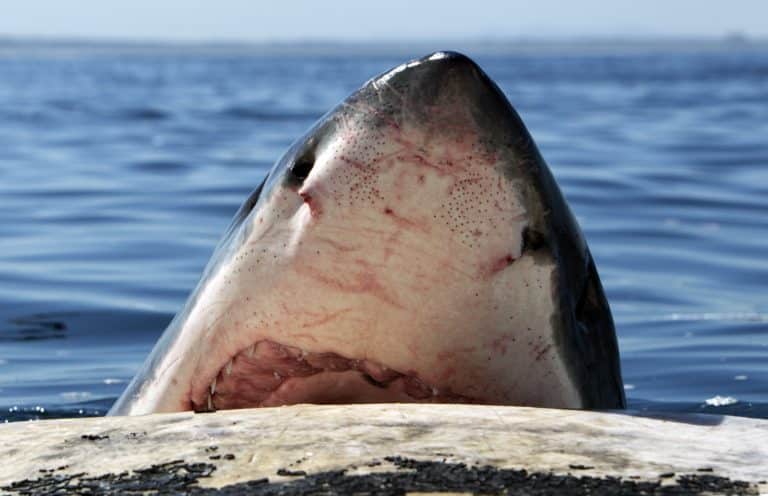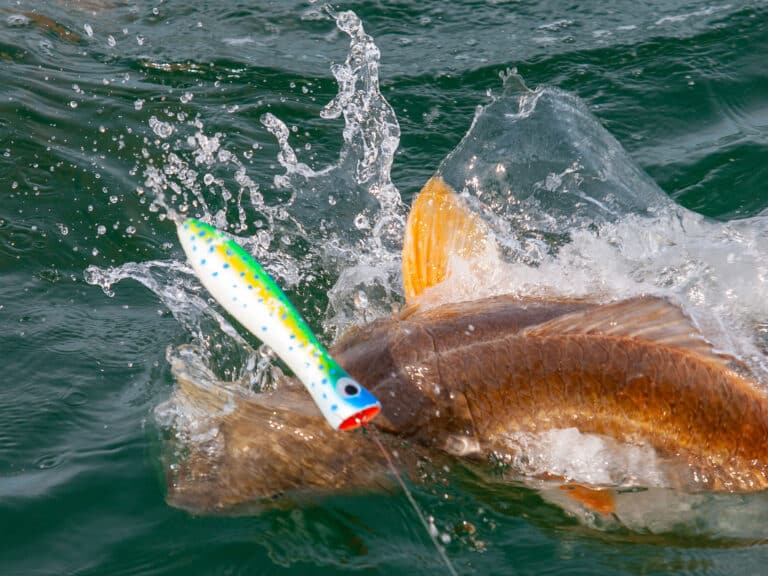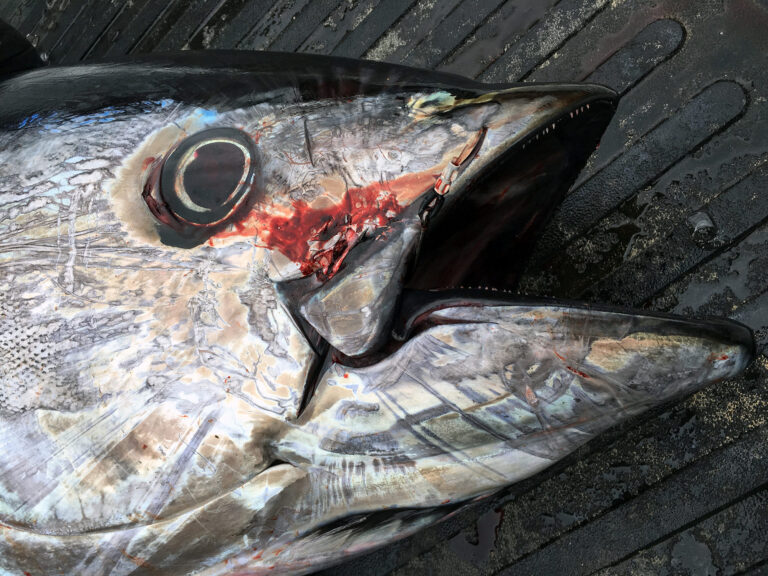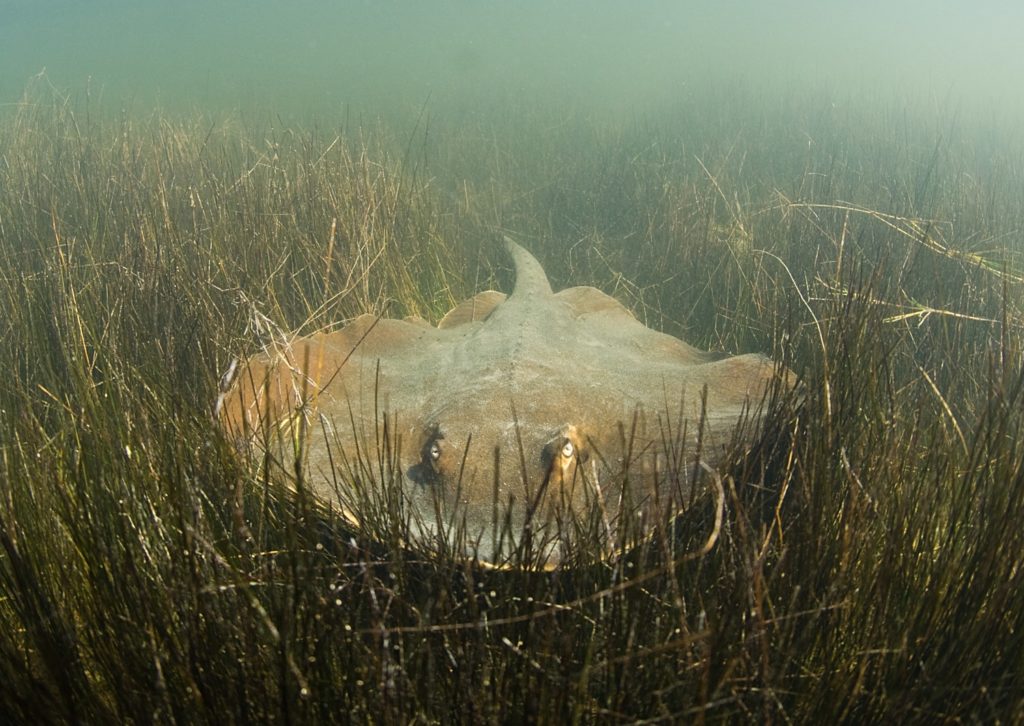
- READ MORE: Fishing’s Most Dangerous Animals — The Impalers (Part 1)
- READ MORE: Fishing’s Most Dangerous Animals — The Biters (Part 3)
Most of us don’t think of sport fishing as a particularly hazardous sport. No doubt statistics would bear out that it’s not. But every sport has its own unique risks, and saltwater fishing is no exception. And as much as the odds weigh against you or me getting seriously injured by something that lives in the sea, you’d better believe it’s possible. In fact, the list of critters worldwide that wait to poke, sting, nip, swallow, infect or otherwise harm you, turns out to be a pretty long and diverse one — probably more so than most of us had ever thought.
To delve into these bad actors of the marine angler’s world, I’ve grouped them into three broad categories, describing the form their particular mischief takes, depending whether they impale, sting or munch you. “The impalers” focused primarily on billfish and needlefish. Photos and words made clear how these fish have seriously injured anglers, sticking their bills through chests, heads and even a nose!
Of course such incidents remains rare, but they do happen — and are among the hazards unique to the sport of fishing. But, as we’ll see in this story, creatures in the sea waiting to sting anglers remain infinitely more plentiful than those that would stab us. Anglers who wade-fish shallow waters are most at risk from creatures that float or swim past, or which lie buried in sand or hidden on rocks. As you’ll see, the sting of some of these may do no more than smart a bit, while others can kill within minutes. But even those in boats don’t necessarily escape getting zapped.
Bad Experiences with Man O War Stings
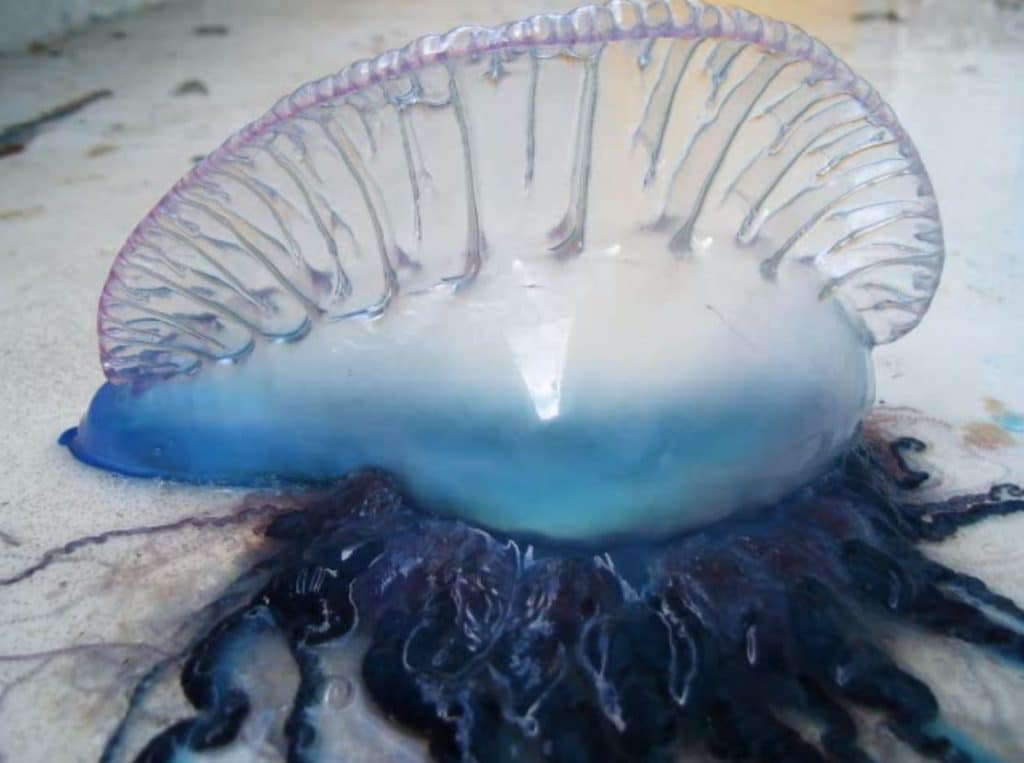
Knowing that the steady, 20-knot tradewind would blow for days, possibly weeks, I wasn’t about to be denied the chance to do some fishing on a Saturday morning. After five days of teaching English to adolescent Trukese on one of the volcanic-peak islands of Truk Lagoon in Micronesia as a Peace Corps volunteer, I was ready to fish. With a short, makeshift pole, I pushed the small skiff to get beyond sandy shallows edging the island. As I whipped it from port to starboard to plant for another push, I felt a burning, piercing sensation on one thigh. Before I could look down, I naturally brushed my hand over the area to rid it of the offending source of pain. Bad move.
At a glance, I realized that the pole had picked up the tentacles of one of the many small, Pacific man-of-wars that the wind had been sweeping in that day from the large lagoon. Then the pole’s co-conspirator, the wind, blew the delicate, translucent blue strings right onto my leg. I also realized, as the pain began to increase, that this was the wrong time to be wearing old Levis cutoff shorts. Frantically, I tried to sort out bits of tentacle from the fringe of denim thread, all the while the stinging cells firing away happily. Finally, I just yanked off the shorts.
Within an hour, I was flat on my back, my leg on fire, the pain and swelling having traveled right up into the lymph nodes in my groin. Benadryl and time sorted things out, and beyond some nasty temporary scarring, I felt fine the next day. Although this happened decades ago, obviously I remember the whole incident clearly. And what I remember most is the pain — yet I was lucky since that pain pales compared to the sting of many other marine animals.
Dangerous and Deadly Jellyfish Stings
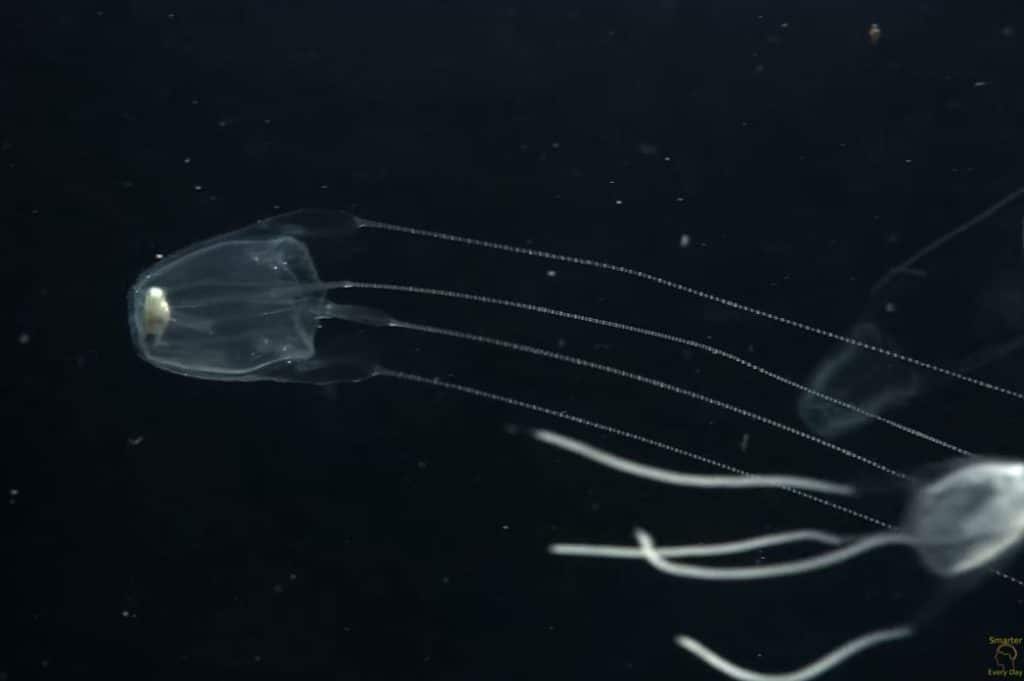
It’s surprising just how many marine critters seem to have cornered the market for pain via their stings. Most won’t actually kill you; they’ll just hurt you. Others will hurt you and then kill you, too. Some let you live but only after begging to be shot. These inconsiderate organisms include spiny fish, stingrays and the coelenterates — jellyfish and related creatures that account for far more envenomations than any other marine phylum. Of nearly 9,000 species of coelenterates, 100 or so produce stings toxic to humans.
No animal on earth is a more effective assassin nor more inherently exquisite in its deadly beauty than the box jellyfish, sometimes known as sea wasp (Chironex fleckeri), though no wasp was ever so deadly. Little more than a few inches across, the translucent bell and thin tentacles (stretching up to 2 yards) of this small animal are hard to spot. Yet according to the authoritative source, Dangerous Marine Animals by Bruce Halstead (Cornell Maritime Press), “Chironex is one of the most venomous marine organisms known and may produce death within a few minutes.”
Even a mild encounter can leave an angler with a new lifetime definition of the word “pain.” But a good dose from some of the millions of box jelly nematocysts — the individual stinging cells that line tentacles — can mean death within minutes from respiratory and myocardial arrest. Many people in Australia and Indo-Pacific coastal areas die each year after box jelly stings; those who survive describe a pain unbearably intense along with a range of miserable systemic symptoms.
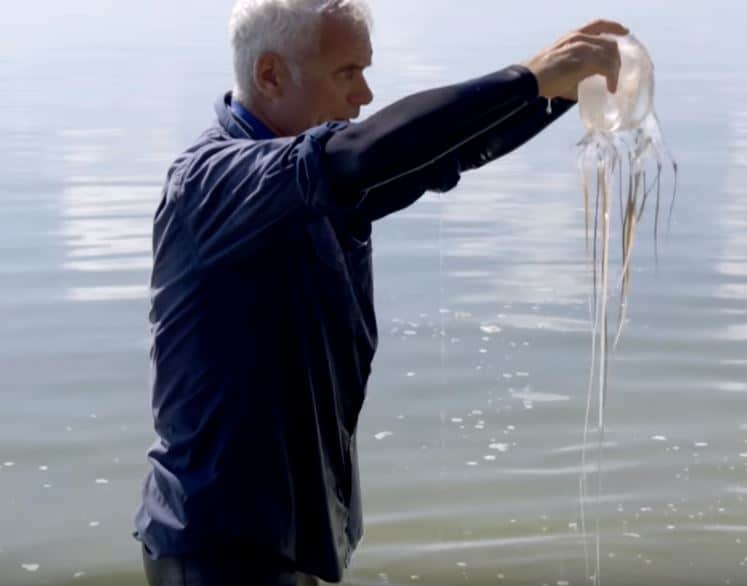
Other jellies, members of the chirodropidae family like the box jelly, show up in the Atlantic as well: A boy in 1990 died after being stung by one off the Texas coast. Underwater photographer Paul Sutherland recalls one angler who went through this nightmare after doing nothing more than cleaning a bit of “trash” — what appeared to be a piece of clear plastic — off his lure’s treble hook.
Most people associate stinging jellyfish with the wide-ranging Portuguese man-of-war, its unmistakable blue, white and pink, balloon-like float carrying it across oceans. I certainly made that association after the run-in described above. In fact, man-of-wars, Physalia physalis, and a smaller Pacific relative, are actually hydroid colonies — not true jellies. But the sting can kill; Physalia deaths have occurred.
But mostly, they just hurt like hell, and most skippers with any time on the water can tell you firsthand of tentacles of fire coming into the boat along with fishing lines; of getting tangled around an anchor rope being hauled in hand-over-hand; or of washing in through a scupper on a rough day or while backing down, forcing anyone not wearing shoes into a lively dance.
How to Treat A Jellyfish Sting
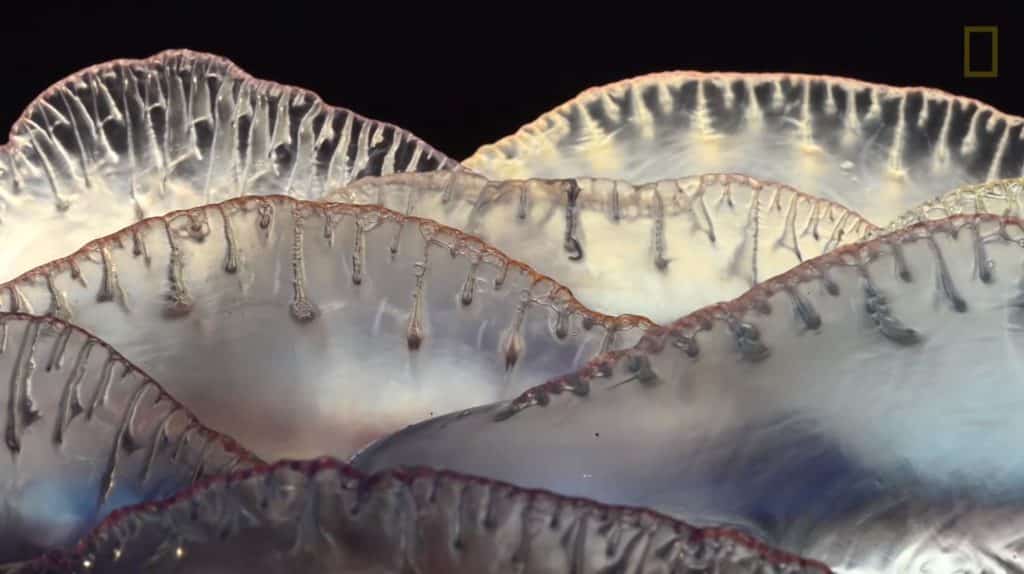
“A big ‘blue bottle’ washed in through the scupper one day,” says veteran Aussie Capt. John Ashley, “and wrapped around my big toe. The sting paralyzed my leg for an hour, and the pain in my groin was unbelievable!”
Toes are bad enough; lips are something else: “The worst man-of-war sting for me occurred one day when I put my cast net’s lead line in my teeth as usual when about to throw,” says Capt. Sam Talbert, describing a morning off Islamorada collecting live bait. Moral of that story, he says: “Don’t eat man-of-war tentacles!”
One can’t always avoid jellyfish stings; too often there’s no visual warning in time to avoid getting nailed. Treatment may include antivenin for box jelly stings, and after a serious sting from any of the more virulent species, hospitalization should be immediate if possible.

In most cases, vinegar (acetic acid) has been shown to help if quickly and liberally applied to the area of envenomation, where pieces of tentacle likely remain stuck to the skin. The vinegar slows or stops the nematocysts from firing and continuing to envenomate the victim — and makes removal of tentacles safer. (Rinsing with fresh water, on the other hand, may actually induce the nematocysts to fire.)
READ MORE: What Fish is This? Florida Saltwater Edition
Probably the best treatment is heat. Immersing the affected area in water at least 96 degrees F should quickly neutralize toxins. (And yeah, the old wives’ tale that peeing on a jellyfish sting works shows those old wives weren’t so dumb: Urine leaving the body is warmer than 96 degrees.) If you want more info, read this study.
The Deadly Stonefish You Should Never Step On
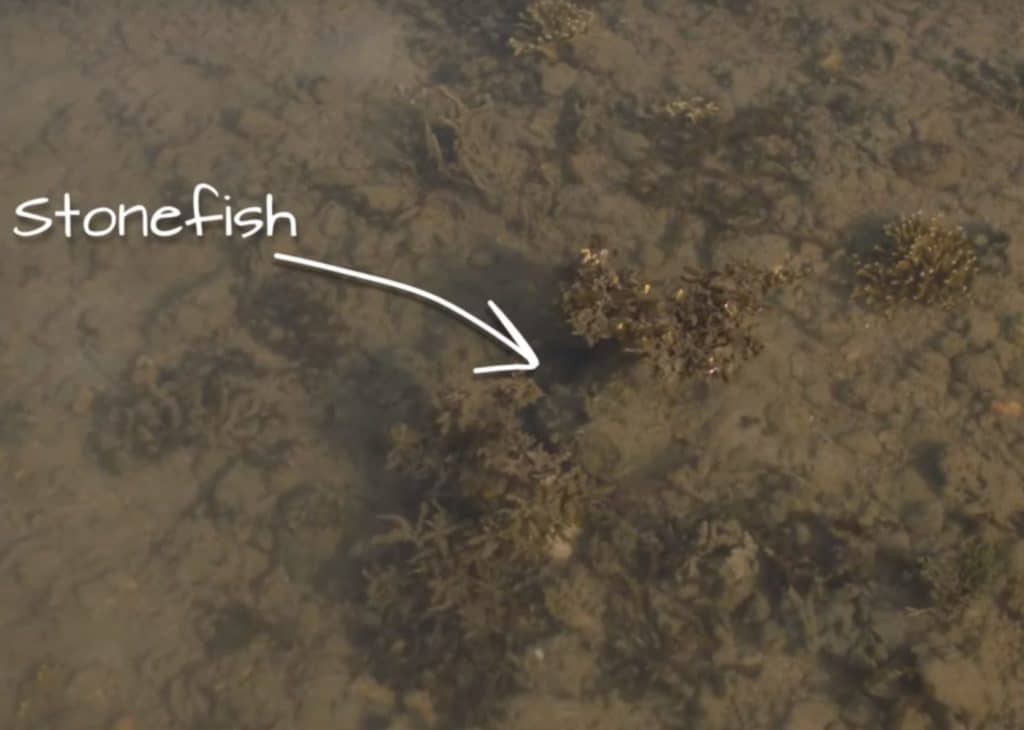
One of the most toxic fish in the world is also one of the most repulsive and, unfortunately, most hard to see. But a stonefish isn’t nearly transparent like a box jelly; rather, it makes itself invisible with a brown, warty exterior that makes it appear for all the world like, well, a stone, resting among stones. But this stone can be lethal.
The scientific name, Synanceia horrida, suits one of the most dangerous of all fishes. Anglers wading in tropical waters where stonefish live — very shallow rocky/sandy areas — run the greatest risk of a fatal misstep. Most of the many species of stonefish which inhabit the tropical Pacific are highly toxic. Each of the stout dorsal spines has its own venom gland: Step down on one and that bulb shoots venom up and out the hollow spine into whatever it has pierced; spines can go (and have gone) right through sneaker soles and into feet.
The classic surfing movie, The Endless Summer, suggested that stepping on a stonefish meant death within 20 minutes. Australia has developed an antivenin serum for stonefish venom. Survivors may wish they were dead, though. Halstead states, “Pain caused by Synanceia is sometimes so severe as to cause the victim to thrash about wildly, to scream and, finally, to lose consciousness.” Some victims require months to recover.
California’s Dangerous Scorpionfish
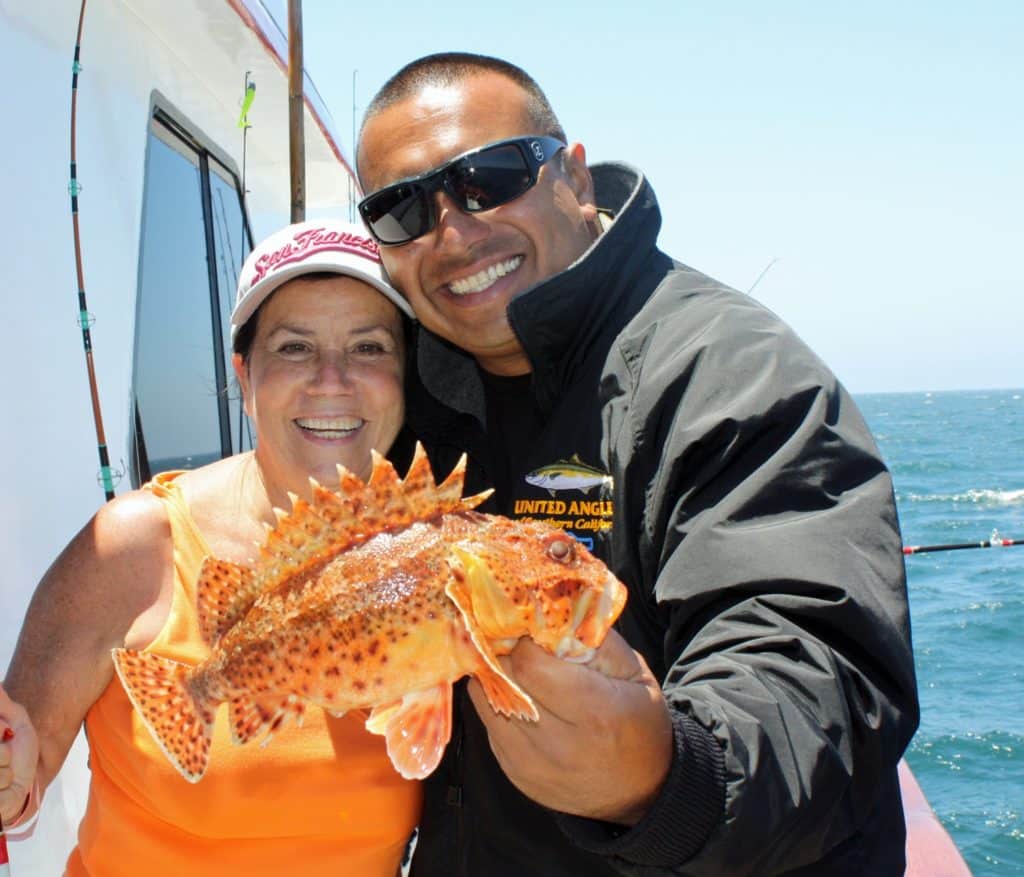
While the stonefish is by far the nastiest member of the family of aptly named scorpionfishes, its cousin, the California scorpionfish or “sculpin” (Scorpaena guttata) so common off the Pacific Coast, accounts for a lot of misery in its own right.
Sculpins have poked most Southern California deckhands at one time or another while cleaning these tasty bottomfish, which eagerly strike small baited hooks. Sculpin lack hollow spines with individual venom glands, but deep grooves carry a strong poison that makes itself felt right off.
“We call ’em rattlesnakes,” says Santa Barbara, California, skipper David Bacon. “Years ago, my deckhand, Tiffany, generally saved them to fillet last because, if she got poked, her hand would swell up by about a third and hurt for three days.”
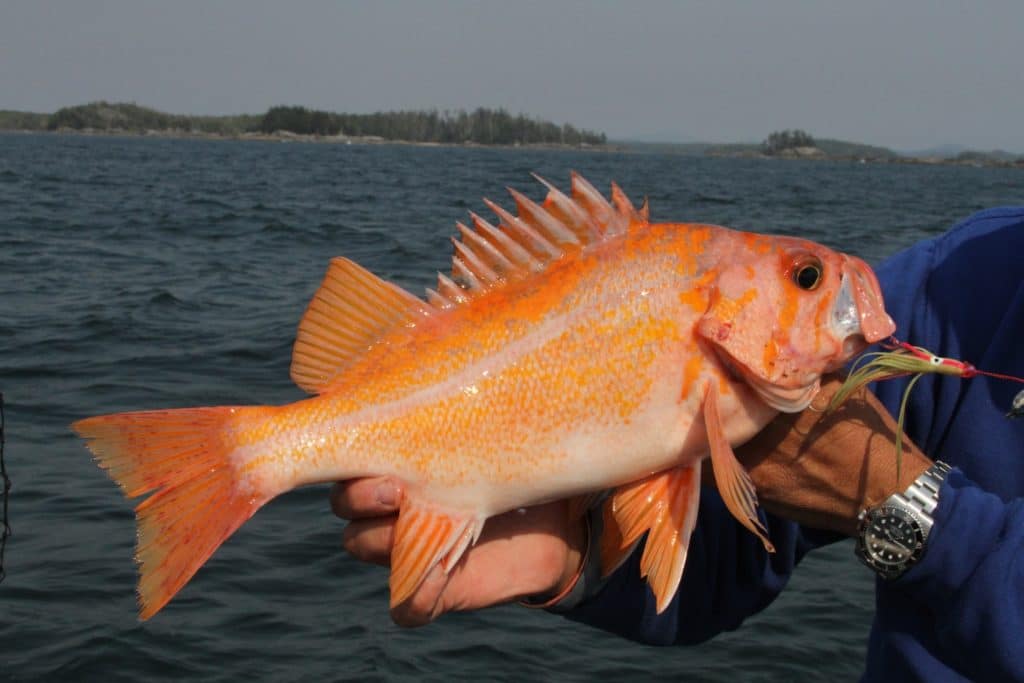
The vast group of rockfishes (Sebastes), also in the scorpionfish family, are abundant and important up and down the Pacific Coast to both sport and commercial fishermen. They come equipped with only shallow grooves and a toxin more like a nasty bee sting than a scorpion strike. But a deep puncture can produce pain unpleasant enough to put a crimp in one’s fishing day.
My fishing day in Washington’s San Juan Islands had already ended when I was about to learn the hard way how to treat (and not to treat) rockfish stings. My hand slipped as I sliced into the dorsal surface of a (well-named) quillback rockfish; suddenly I had about a half-inch of dorsal spine in my finger. I pulled it out, rinsed the wound and went on filleting. In about 15 minutes, the pain made filleting seem like a job better put off. I went inside and thrust my hand into a small bucket of ice water. Big mistake, as it turned out. The pain continued to worsen until, with my hand throbbing in agony, I managed to call a physician who knew how to treat rockfish stabs. Taking his advice, I switched from ice water to hot water — very hot. In minutes, the pain had pretty much vanished.
I’ve had occasion since then to use the hot-water treatment; it works since rockfish venom (like many types of venom) is heat-labile. (But physician follow-up for infection and tetanus is always advisable.) You can find more information about envenomation from scorpionfishes at this guide.
Anglers Need to be Careful with Rays

While his wife and kids busied themselves seeking shells, Tom Twyford, former president of the renowned West Palm Beach Fishing Club, waded quiet sandy flats near Gasparilla Pass in southwest Florida. Although he had noticed a few rays, they were quite small, and he decided to walk barefoot while casting for tarpon, leaving his wading booties in the boat.
“A little while later, I thought I had bumped into a sharp shell. Then the reality of what had happened sunk in as I began to feel a burning sensation,” Twyford says. “I never did see the skate — just the puff of sand where it had taken off. At first the sting seemed minor; I cussed the ray and my stupidity, but kept on casting. Then the pain began to creep up my leg.”
By the time they had cruised back to the dock, about 45 minutes later, Twyford was nauseated, his foot and lower leg had grown numb, and his upper leg throbbed acutely. Fortunately, it was a small hit, leaving no part of the stinger embedded, or a trip to the hospital would have been likely. Long hours later, the pain subsided. “But it took nearly three weeks for the wound to heal entirely.”
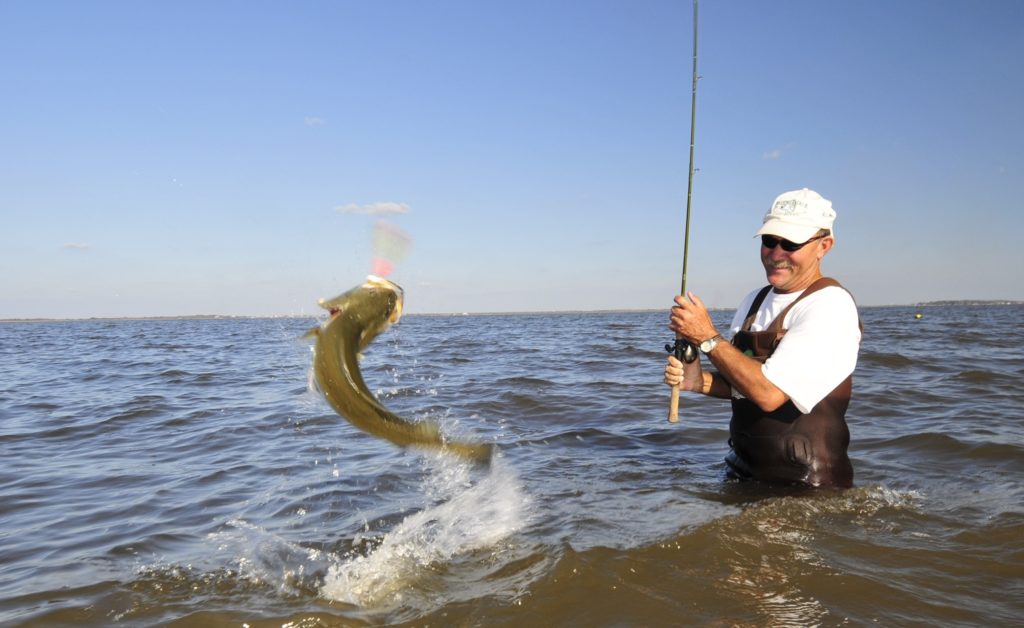
Stingrays are a fact of life for warm-water wade-fishermen. Rays’ habit of lying still atop or buried under the sand in shallow areas makes stepping on one all too possible. A big ray can whip its muscular tail around with tremendous force, driving into the calf of an unwary angler their flattened, bone-hard spine with serrated recurving teeth. That means, like a barbed hook, it goes in a whole lot easier than it comes back out. Worse, the spine may break off in an angler’s leg; those recurved teeth may rip and shred flesh unmercifully as the spine is yanked back out.
Prevention calls for “the Texas shuffle” while wade-fishing. Generally, even rays buried in the sand (with only their eyes sticking up) will scoot out of the way given the chance. Also, anyone who spends much time wading stingray-rich flats should invest in a pair of protective wading boots (not shoes). Some boots, for example, have a Kevlar lining that extends to mid-calf height. Texas inshore guide Bink Grimes says he’s been hit twice by stingrays; neither penetrated the Predator boots he wore.
Despite the tragic death of internationally known TV personality Steve Irwin when he was apparently attacked by a large stingray in 2006, the fact remains that ray stings occur almost always as a defensive reaction when stepped on or disturbed. Otherwise, they almost never show aggression. That’s a good thing, because the hard, bony spines on their tails have deep grooves laden with venom-producing tissue that runs the length of the spine. Beyond sharp shooting and throbbing pain, stingray injuries may result in loss of blood pressure, vomiting and diarrhea, and rapid heartbeat. Muscular paralysis and death may follow in severe cases.
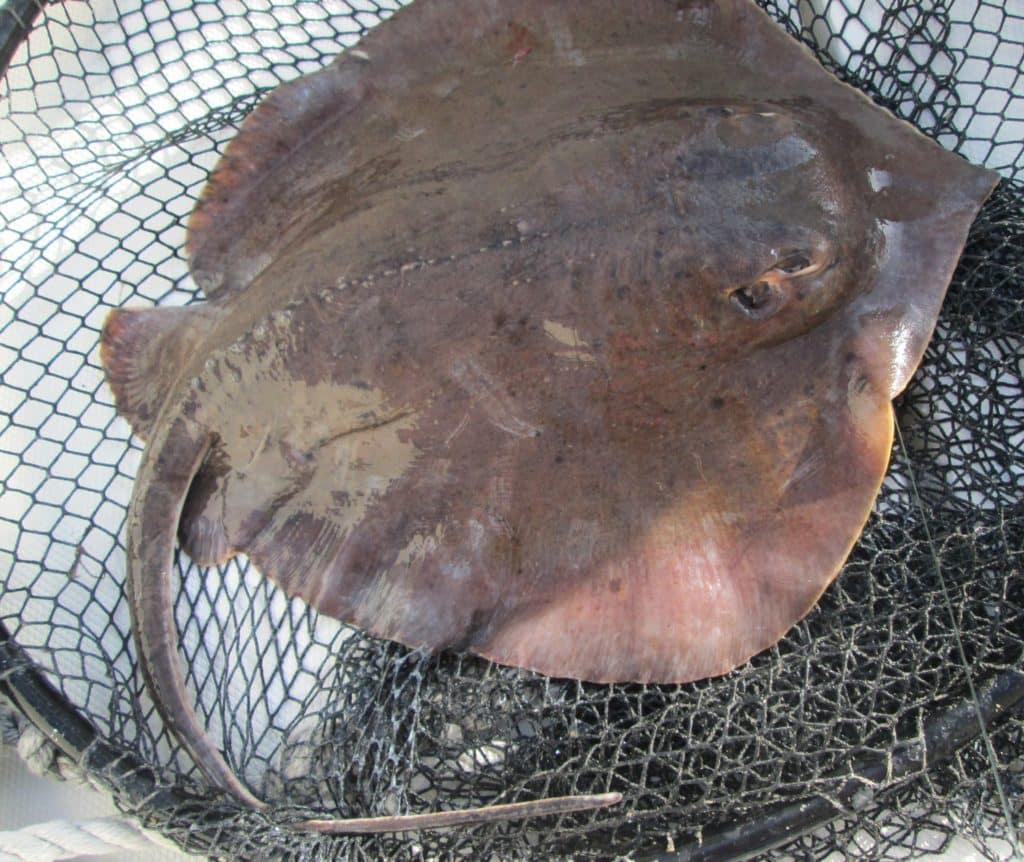
Eagle and bat rays can also deliver a nasty sting, but not as easily since their stingers (often multiple) are higher up and not as close to the end of their tails. But under rare circumstances, eagle rays may present a very different danger, thanks to their habit of suddenly leaping high out of the water in popular fishing areas like Florida Bay. As unlikely as it seems, at least one guide has been knocked out of his skiff while at the helm, zooming at high speed over the bay. In the Florida Keys in 2008, a 75-pound eagle ray leaping clear of the water collided with a woman in the bow of a running skiff, killing her.
As with many marine venoms, stingray toxin breaks down quickly under heat. Fishing writer and photographer Graeme Pullen, of England, had a woeful experience much like mine with rockfish. While sitting in a skiff, Pullen pulled a hooked ray partly out of the water for a photo — and wished he hadn’t. He ran back to his hotel room in the Florida Keys and applied ice. The pain became excruciating. He finally contacted an expert who advised very hot water. “Within 30 seconds, the pain had eased,” Pullen says.
Infection is likely to be the major problem long after the pain subsides. “The fibrous sheath that surrounds the barb drags all over the bottom of an estuary and is covered with bacteria,” says Capt. Mike Holliday, who has considerable experience with rays. “The sheath [or pieces of it] usually remains in the hole made by the spine, even after it’s pulled out.”
Stinging Fish: Catfish and Leatherjackets
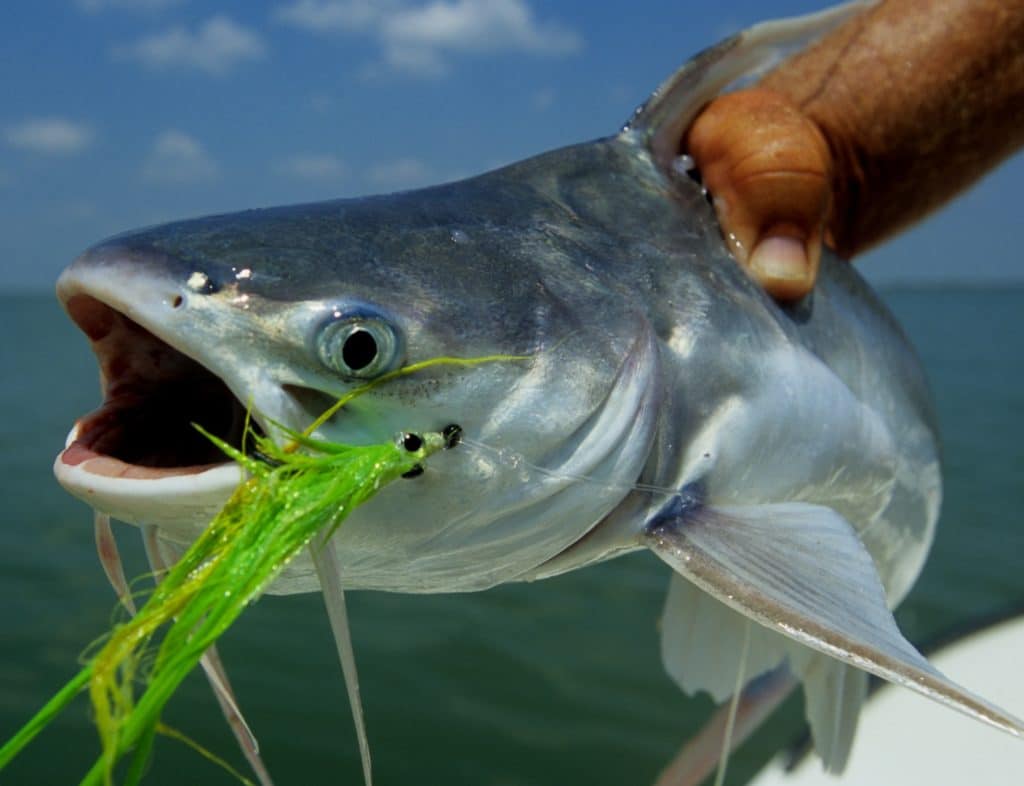
“We were fishing next to an oil rig about 30 miles off the Louisiana coast. The Gulf was rough and the fishing slow — for everything except hardhead catfish,” says John Kumiski, a guide from Chuluota, Florida, who fishes the Indian River near his home where sea cats are hardly unusual.
“I went to grab a catfish I’d caught, but a wave caught the boat, and I missed. The pectoral spine went into one of my fingers.” Rather than yank out the spine with the catfish still wriggling, Kumiski cut the spine off, then had his partner yank it out as cleanly as possible. “My arm swelled to above the elbow; my fishing was definitely finished for that day.”
Most catfish carry potent toxin on their needle-sharp dorsal and pectoral spines, which they can lock securely into place. Hardheads and gafftopsails (“sail cats”) so ubiquitous from Texas to the Central Atlantic states are no exception as Kumiski and thousands of other anglers can attest.
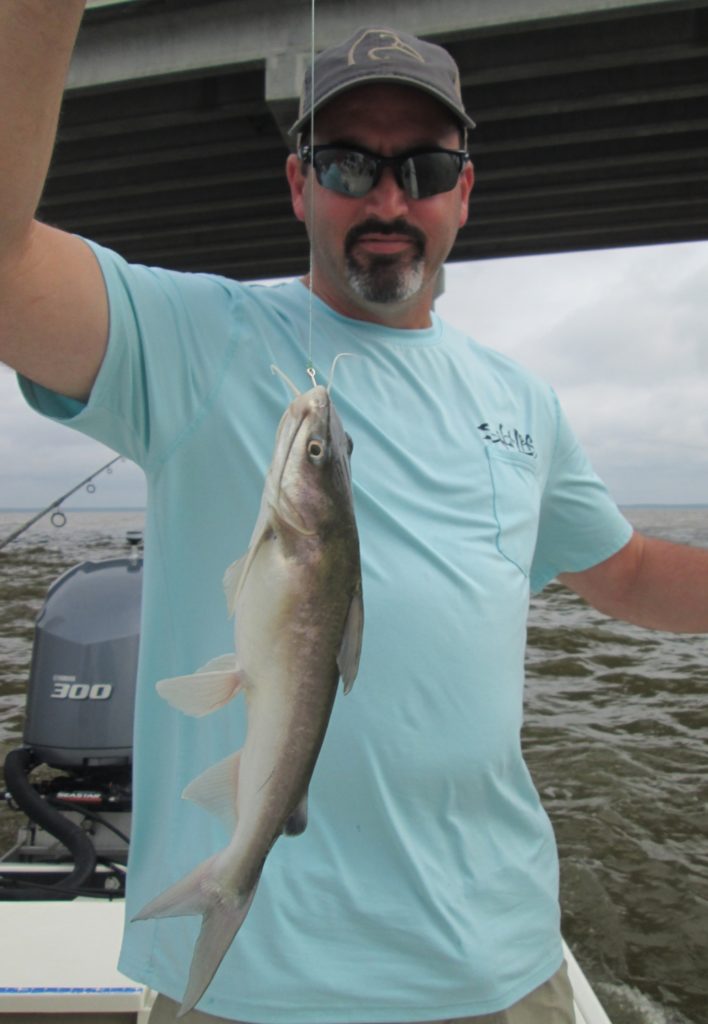
Like rays, a sheath of skin covers the catfish’s spines; the outer layer contains venom cells. The spines of some species also feature sharp, recurved teeth which further lacerate a wound. A nick may be similar in pain to a wasp sting. Once again, the best treatment for the pain of rays’ stings involves water as hot as the victim can stand to quickly neutralize the toxin and pain. Then, the wound must be cleaned of all bits of material and treated to prevent secondary infection.
One other piece of advice: Never mistake a catfish for a soccer ball.
“I was fishing on a bridge catwalk [in south Florida] one day when a guy unhooked a catfish of a pound or so,” recalls Capt. Holliday. “It fell to the pavement and he tried to kick the fish over. That drove a spine through the toe of his sneaker and into the skin between his two toes. His friend took him to the hospital with the catfish still stuck to his shoe!”
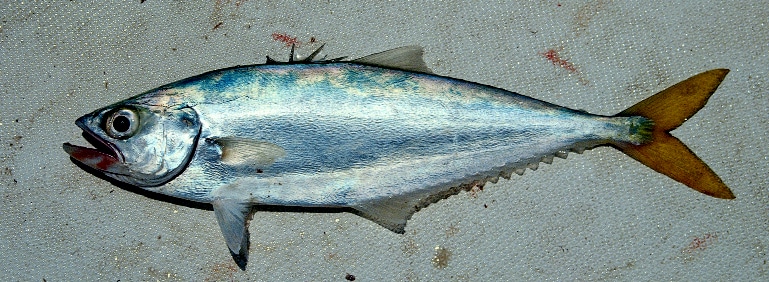
Retired Tampa-area guide Ray Markham, who’s experienced most of these bad actors, says, “The worst sting I’ve felt personally is from a leatherjacket. The pain from being stuck by a dorsal spine of these little critters is truly intense. The sensation quickly travels up your arm from your hand — the swelling is awesome! The shooting pains throb for a very long time.”
This slender member of the jack family reaches only a foot or so in length. It’s an attractive little fish, silver with bright yellow tail and finlets. Voracious, schooling leatherjacks readily hit small lures. But watch out for that row of short, spiky spines ahead of the dorsal fin. And if they don’t get you, the two sneaky ventral spines, just before the long anal fin, might.
Capt. John Cooper of Fort Lauderdale agrees with Markham’s assessment of leatherjacks. “Their spines cause an incredible amount of pain. Commonly called ‘skipjacks,’ they look harmless enough, but their spines pack a punch!” Cooper says. “And don’t try the flipper technique [flipping the fish off the hook as one would a pilchard or the like] either. Use an extra-long needle-nose pliers, or just cut the leatherjack off.”


